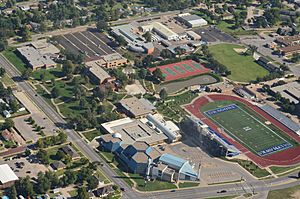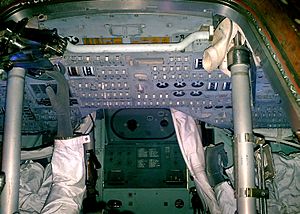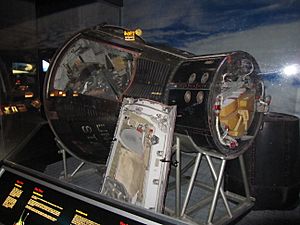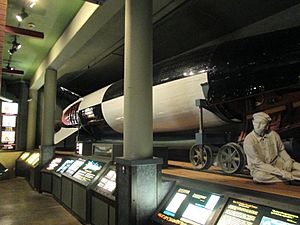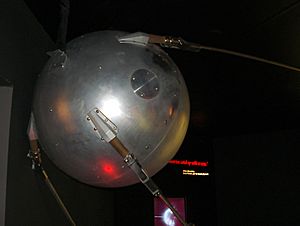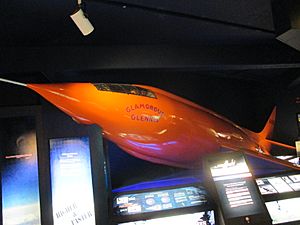Cosmosphere facts for kids
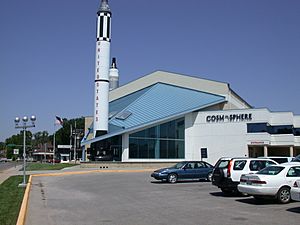
Main entrance (2003)
|
|
| Lua error in Module:Location_map at line 420: attempt to index field 'wikibase' (a nil value). | |
| Established | 1962 |
|---|---|
| Location | 1100 North Plum Street Hutchinson, KS 67501 USA |
| Type | Space Museum |
| Collection size | 15,000 |
| Visitors | 150,000 / year |
The Cosmosphere is an exciting science education center and space museum. It is located in Hutchinson, Kansas, in the United States. This museum is home to one of the largest collections of space artifacts in the world. You can find items from both American and Russian space missions here. The Cosmosphere also offers many fun and educational programs about space. It started as a small planetarium in 1962.
Contents
What You Can Explore at the Cosmosphere
The Cosmosphere is a huge place, about 105,000 square feet! It has an amazing collection of Russian space items, the biggest outside of Moscow. Its collection of U.S. space artifacts is second only to the National Air and Space Museum in Washington, D.C.
The museum has five main areas for visitors to enjoy:
- Hall of Space Museum: This is where you can see all the incredible space artifacts.
- Justice Planetarium: Here, you can watch amazing shows about stars and planets. It was updated in 2015 with a new digital projection system.
- Carey Digital Dome Theater: This theater shows films on a giant dome screen. It was upgraded in 2012 to a super clear 4K digital system.
- Dr. Goddard's Lab: Get ready for an exciting live science show! You'll learn about the history of rockets with cool demonstrations.
- CosmoKids: This is a special area where younger visitors can learn through hands-on activities. It focuses on STEAM (Science, Technology, Engineering, Art, and Math).
The Cosmosphere also hosts summer camps for all ages. They have special programs for school field trips and scout groups. These programs help students learn about science and prepare for future careers. The Cosmosphere is the only museum in Kansas that is connected with the Smithsonian Institution.
In 2021, some of the museum's oldest exhibit areas were updated. These included the German Gallery, the Redstone and Sputnik Gallery, and the Kennedy Theater. They received fresh paint, new graphics, and improved sound.
Bringing Space History to Life
The Cosmosphere has a special team called SpaceWorks. This team works to fix and restore real U.S. spacecraft. They have restored artifacts for museums all over the world, including for the Smithsonian Institution. Two famous examples of their work are the Apollo 13 Command Module Odyssey and the Liberty Bell 7 spacecraft. Both of these amazing pieces of history are on display at the Cosmosphere.
SpaceWorks also helps create props and replicas for movies and TV shows. They built about 80% of the props for the movie Apollo 13. They also made replicated spacecraft for the film Magnificent Desolation: Walking on the Moon 3D and the TV mini-series From the Earth to the Moon.
Amazing Space Collection
The Cosmosphere's collection includes many real items that have been to space. You can see a Lockheed SR-71 Blackbird spy plane and the Liberty Bell 7 Mercury spacecraft. Also on display are the Gemini 10 space capsule and the Command Module Odyssey from Apollo 13. Outside the building, you can see real Redstone and Titan II rockets. These rockets were used in the Mercury and Gemini space programs. A very special item is a real Moon rock from Apollo 11, the first mission to land people on the Moon.
Every item you see at the Cosmosphere is either a real flown artifact, a "flight-ready backup" (meaning it's exactly like the one that flew), an engineering model, or a very accurate replica.
The museum's exhibits take you on a journey through space history. You'll learn about early rockets from World War II. Then, you'll explore the exciting Space Race and Cold War era. The journey continues through the Space Shuttle program and the International Space Station. You can also learn about newer space ventures like SpaceShipOne and private space travel.
Here are some of the notable items you can see:
From Germany
- World War II Era:
- A real, restored V-1 flying bomb missile.
- A real, restored V-2 rocket.
- A Walter HWK 109-509 rocket engine from a German plane.
- Cold War Era:
- A piece of the Berlin Wall, which was the last section removed.
From Russia and the Soviet Union
- Early Satellites:
- Early Space Programs:
- A Vostok space capsule, similar to the one used by the first person in space.
- A Voskhod 2 space capsule.
- Joint Space Programs:
- A full-size replica of the Apollo-Soyuz Test Project spacecraft. This was a mission where American and Soviet spacecraft linked up in space.
- Other Space Items:
- Real Russian space suits.
- An RD-107 engine, used on the Soyuz rocket.
From the United States
- Winged Aircraft:
- A real Lockheed SR-71 Blackbird reconnaissance plane.
- A Northrop T-38 Talon supersonic jet trainer, painted like a NASA plane.
- XLR11 and XLR99 rocket engines from the North American X-15 program.
- A replica of the Bell X-1 Glamorous Glennis, used in the movie The Right Stuff.
- A real engine from the Bell X-1 Glamorous Glennis, flown by pilot Chuck Yeager.
- Early Satellites:
- A replica of the Explorer 1 satellite.
- A backup of the Vanguard 1 satellite.
- Mercury Space Program:
- The Liberty Bell 7 Mercury spacecraft. This spacecraft was recovered from the bottom of the Atlantic Ocean. It's special because the Cosmosphere owns it, not NASA or the Smithsonian.
- A real Mercury-Redstone Launch Vehicle rocket, standing tall outside.
- Gemini Space Program:
- The real Gemini 10 space capsule.
- A real Agena target vehicle docking collar.
- A real Titan II rocket, also standing vertically outside.
- Apollo Space Program:
- The real Apollo 13 command module Odyssey.
- A full-size replica of the Lunar Roving Vehicle, used on the Moon.
- A full-size replica of the Lunar Module and surface experiments.
- A real Apollo White Room piece.
- A real Moon rock collected during Apollo 11.
- Many real cameras and items carried on Apollo flights.
- Parts of a Rocketdyne F-1 engine, recovered from the ocean.
- Space Shuttle Space Program:
- A full-size replica of the left side of the Space Shuttle Endeavour.
- A piece of tile from the Space Shuttle Columbia disaster.
- Other Space Items:
- Real American space suits.
- Various rocket engines like the RL10, H-1, F-1, and Merlin 1D.
More to Explore
- Strataca, a salt mine museum in Hutchinson.
- Combat Air Museum in Topeka.
- Kansas Aviation Museum in Wichita.
- Mid-America Air Museum in Liberal.
- List of aerospace museums
- List of museums in Kansas
See also
 In Spanish: Kansas Cosmosphere and Space Center para niños
In Spanish: Kansas Cosmosphere and Space Center para niños


